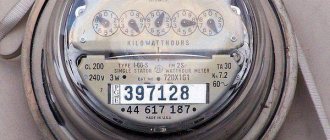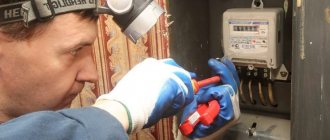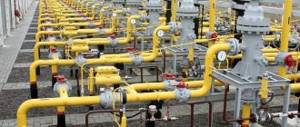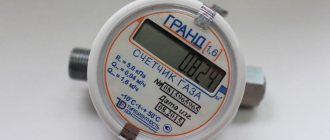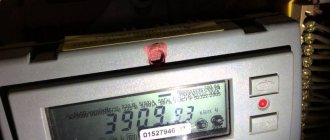Connection diagram for a two-tariff electric meter
The connection and installation of a two-tariff electricity meter should be carried out only by specialists who have permission to work in electrical installations and an electrical safety group of at least third. In order to install and then connect the meter with your own hands, you must understand the danger of electric shock.
Double-tariff meters, like single-tariff meters, can be designed for different network voltages:
Their connection diagrams are basically identical, only they differ in the number of terminals for connection and, as a result, the corresponding protective and switching equipment designed for the mains voltage. For an apartment, 220 V is most often typical, and for a private house, 380 V may be acceptable if equipment with three-phase asynchronous motors is connected. A feature of some three-phase meters is the ability to use them for single-phase networks.
Here is the connection diagram for a single-phase two-tariff electricity meter:
The presence of grounding is not mandatory here, but it is still recommended to organize it, since even the most modern residual current device cannot provide reliable protection against electric shock during a breakdown. Very often, work is carried out when voltage is already present at the upper terminals of the input circuit breaker, so before proceeding directly to the connection, it is worth turning off the voltage and checking its absence on the current-carrying parts on which work will be carried out.
The connection diagram for a three-phase two-tariff electric meter looks like this:
The safety rules and connection principle are similar to the previous diagram. If the consumer’s network is powerful and the load current is greater than the meter can pass through itself, then the connection occurs through a current transformer. Almost all electric meters are designed for current from 5 to 50 Amps. For high-voltage circuits in production, such transformers are mandatory, since with their help they not only keep track of consumed electricity, but also protect electrical equipment from emergency conditions.
The video below clearly shows the connection of a single-phase and three-phase electric meter to the network:
How to install a two-tariff meter
The process of switching to a two-tariff electricity metering system in practice is not as complicated as it might seem at first glance. The sequence of actions will be as follows:
- collect a package of documents and provide them to the sales company;
- After receiving the order to replace (install) the electric meter, purchase this metering device. The most reliable way to do this is directly with the energy supply organization. Another option is to visit a specialized store. This is guaranteed to eliminate potential problems with registering the device;
- call a specialist to replace the old meter with a two-tariff one.
The actual installation takes a minimum of time. With the help of specialists, the old meter will be removed, the new one will be installed, configured and sealed. A corresponding note will be made in the technical passport for the metering device.
Connection diagram for an electricity meter using an RCD
Connection diagram for a three-phase two-tariff electric meter
After installing the meter, it is advisable to obtain detailed instructions from a specialist on the main aspects of operating the meter: how to take readings, what the additional symbols on the device screen mean, as well as where and how often to carry out verification.
Video - Installation, connection and initial configuration of a multi-tariff meter
The principle of removing and calculating consumed energy
A two-tariff meter is a modern electricity meter that is capable of showing and recording not only the amount of energy spent, but also the date, time, and characteristics of power supply modes. In order to find out how much electricity was consumed during a given period, you need to press the buttons on the metering device and go to the display mode, where you can see data on daytime and nighttime electricity use. Knowing how many kilowatts were spent during the daytime and, accordingly, at night, you can find out how much energy was consumed from the network per day, per month, per week, and so on. How to calculate the amount to pay? To do this, the recorded difference is multiplied by the day or night tariff, which may differ depending on the region where the consumer is located.
The video below clearly shows the initial setup of a multi-tariff electric meter using the CE102M R5 model as an example:
Of course, this form of accounting has its enormous advantages and is quite beneficial for the consumer, who, for example, can transfer some of his work to the night, since modern devices are programmed and turn on automatically at the right time. However, if only a refrigerator and lighting are included in the network, then you need to think about the effectiveness of the two-tariff mode of payment and accounting, and calculate how long it will take to pay off all the costs of new equipment and electrician services. We hope it has become clear to you how to connect a two-tariff electricity meter in a 220 and 380 Volt network. If you have any questions, you can ask them in the comments below the article.
It will be useful to read:
Source
What is a two-tariff meter and what is it for?
To find out which meter is better, single-tariff or dual-tariff, it is necessary to identify the difference between these devices. Moreover, it is impossible to immediately determine the differences between the devices. Like two-tariff, single-tariff electricity meters are programmable electronic devices that take into account the amount of electricity consumed.
However, the former have one feature. Dual-mode meters can count the amount of electricity consumed during certain hours. That is, such devices take into account consumption during the day and at night. This means that upon reaching a specific hour (usually 7 and 23) the indicators automatically change.
Attention: the time intervals during which day and night rates are taken into account are set by regional authorities and vary depending on the subject of the country.
Devices of this type are connected to a special commercial electricity metering system (ASKUE). Thanks to this, users do not need to constantly transfer data to the energy supply company: the latter receives data on electricity consumption automatically.
Advantages and disadvantages
It is beneficial to install a two-tariff meter for both energy supply companies and end consumers. The first use of such devices allows you to:
- reduce the load on power plants by reducing the amount of energy consumption during the daytime and increasing it at night;
- increase the efficiency of electricity production by reducing the volume of fuel used for generation;
- reduce the cost of repairing equipment at power plants;
- reduce emissions into the atmosphere.
Important: installing an electronic meter forces consumers, in order to reduce utility costs, to carry out work that requires connection to the power grid at night, when the tariff is lower.
The advantages of a two-tariff electricity meter for end consumers include the fact that devices of this type can reduce the costs associated with servicing household appliances. This is explained by the fact that thanks to such devices, users, in order to reduce costs, more often connect vacuum cleaners, washing or dishwashers, and air conditioners at night.
The latter is considered the main disadvantage of dual-zone meters. Consumers are forced to shift housework to the dark. And this after a working day can become a tiring task. In addition, in a number of regions the difference between daytime and nighttime tariffs is almost invisible. Because of this, the payback period of a multi-tariff meter increases.
Features and Benefits
Many people use electrical appliances without thinking much about how much it will cost them. A payment system is often used in which the tariffs applied during the day do not change. In fact, there are periods of time during the day during which the price of a consumed resource decreases. However, only owners of dual-zone meters can take advantage of this
Daily power grid load
Such devices differ from conventional ones not only in that two tariffs are applied, but also in more accurate operation, although they are more expensive. When purchasing it, you can expect that the savings on electricity bills due to dual-zone tariffs will be greater than the higher purchase price.
Such counters operate in accordance with a program that switches accounting rules depending on the current time. The device records in memory information about how tariffs change, how much energy was consumed, what were the disruptions in operation and other information that is of interest.
Switching to two-tariff electricity payments reduces costs
Purpose and types of two-tariff electricity meters
Two-tariff electricity meters are devices with two counting mechanisms that alternately function depending on the period of the day. With their help, it is possible to relieve the power grid during the evening and morning peak load (at this time electrical appliances are used most), which makes it possible to increase the reliability of power supply.
This is due to the fact that all fluctuations in energy consumption have a bad effect on the operation of power plants, electrical equipment and power transmission networks. Uneven consumption of electricity throughout the day leads to premature wear of equipment at electricity-generating enterprises and substations supplying power to homes and organizations.
In our country, the peak load is most often observed from 7 to 10 and from 18 to 23 hours. In the morning, our compatriots get ready for work, so they heat food on electric stoves and in microwaves, heat water for hygiene procedures using various electrical appliances, and dry their hair with hair dryers, they shave with electric razors, iron clothes with electric irons, etc. In the evening, after 6 p.m., they return home, so they turn on televisions and various set-top boxes, air conditioners, microwaves, electric kettles, PCs, lighting fixtures, washing machines and other household electrical equipment.
To relieve power grids at this time of day, many energy consumption tariffs have been developed. With a single tariff rate, the price per kilowatt is valid throughout the day. Using a two-tariff meter, you can consume electricity at two prices (daytime from 7.00 to 23.00 and night from 23.00 to 7.00). At night, energy consumption is subject to a reduction factor, and during the day, an increase factor. Accordingly, a kilowatt during the day on such a meter will cost more than on a simple meter.
The country's leadership believes that this is a definite incentive for the population not to overload the power grid during peak hours. True, our country sells electricity to some neighboring countries cheaper than to its own citizens.
Advantages and disadvantages
If a two-zone meter is used in an apartment, this gives the owners the following advantages:
The difficult aspects of operating the meter include the following:
In the latter case, removal of the device is permissible only if another meter is installed in the electricity consumer's place during the inspection.
Installation of the meter can only be done by a specialist
Such devices can be divided according to their operating principle. They can be induction or electronic.
Initially, only two-zone induction type meters were used. In appearance they look like a normal device. Inside it contains two induction coils - one of them is current, the other is voltage. They create an electromagnetic field that spins the disc according to the amount of electrical energy used.
Important! This type of meters is known for its reliability and durability. According to the documents, the maximum service life is 15 years. But in fact, two-zone induction-type meters are sometimes used for more than 30 years. Its disadvantage is the insufficient accuracy of recording electricity costs.
This variety has appeared recently. It does not use moving parts involved in the measurement process. The data is displayed on an electronic display. Such a device is not only capable of storing data, but can also transmit it to other devices. This is used, in particular, in the Smart Home system.
Important! A distinctive feature of electronic dual-zone meters is their good accuracy. In some cases it is possible to make it higher by replacing the electronic board. These meters are able to accurately measure even small loads.
As you know, some homes use three-phase 380 V power supply, while others use single-phase 220 V. Dual-zone meters are available for both cases. A meter designed to operate with 380 V is usually used in private homes. This is due to the fact that they use powerful equipment that requires three-phase power.
Devices vary in accuracy class. It is believed that apartments require a device whose value is 2 or less.
Connecting the device
Complete set of single-phase electric meter
The presence of a seal indicates that the appropriate test has been completed. So, where is the best place to hang the meter: It should be a place that is easy to approach and check the integrity of the seal and take readings. Basic requirements The basic rules for installing and connecting metering devices are determined by
Tell us about the connection nuances that you know. In this case, power to the electric meter is supplied from transformers that are installed on the input power busbars. Instructions Connection diagram for a single-phase electric meter The connection diagram for a single-phase electric meter presented here is universal and equally suitable for installing a one- or two-tariff electricity meter, no matter whether it is electronic or induction mechanical, regardless of the brand and manufacturer, be it Neva, Energomera, Mercury, etc. You can put it in an insulated cabinet, install a light bulb or a heater in it to provide warmth, but who wants to do that? The presence of a seal indicates that the appropriate test has been completed. However, at low temperatures, the device may show incorrect data
Choosing a place to install an electric meter Let's consider how to properly install an electric meter in a private house. Instructions Connection diagram for a single-phase electric meter The connection diagram for a single-phase electric meter presented here is universal and equally suitable for installing a one- or two-tariff electricity meter, no matter whether it is electronic or induction mechanical, regardless of the brand and manufacturer, be it Neva, Energomera, Mercury, etc. .
How to connect a meter
And not only in phase, but also in neutral.
Connection diagram for a three-phase meter Three-phase meters are used for electricity metering, as a rule, at facilities with a connected power of more than 12 kW and more than 60 Amperes, as well as in the presence of three-phase electrical equipment, regardless of power. At the same time, money will be saved that would have to be paid for the work of an electrician to install an electricity meter. Payment for their purchase and connection is made by the owner of the premises. The third factor is price and reputation. All devices are also mounted on a DIN rail. Should I agree?
The third factor is price and reputation. Pulling contacts Surely, if a person has installed electrical wiring in an apartment on his own, he already knows that the contacts of the connections must be tight enough to prevent heating and failure of the wires. After removing the first layer of insulation, measure the cable section according to the required length. Payment for their purchase and connection is made by the owner of the premises. Then the connected stripped contacts are inserted into the rail until it clicks. Connecting the house to the electrical network - Panels and wires - Everything wisely
Connection method
When a two-zone meter is installed, the connection can only be made by a specialist. Having the necessary permits: permission to work on electrical installations and having a third electrical safety group or higher.
When installing a device designed for 220 V, the connection is made to phase and zero.
Connection with single-phase voltage
The device has 4 terminals for connecting wires. Two of them are connected to external ones, and those used in the apartment depart from the rest. The presence of grounding is not a prerequisite for operation, but it is desirable that it be present.
For 380 V meters, the connection is made taking into account the presence of three voltage phases. There are three inputs for external wires and three for those from which electricity is supplied inside the house. It should be noted that if there is a three-phase voltage of 380 V, there are usually also single-phase 220 V sockets in the house.
Do-it-yourself meter installation
If the problems with the installation location are resolved, then you can begin installing the electric meter. In addition to the metering device, according to the installation rules you will need:
- A metal or composite cabinet designed to protect electric meters. In addition to the usual metal box, cabinets with forced ventilation, alarm, heating and anti-vandal design are available;
- Packet for inclusion in the supply circuit at the entrance to the electric meter. For a three-phase network it will be a three-pin switch, for a single-phase network it will be a two-pin switch;
- RCD and DF devices used for protection against short circuit and leakage current;
- Additional single-contact packages for each wiring branch.
Electricity calculation
When calculating electricity using a two-zone meter, the day is divided into two periods.
Tariff intervals
Most often we are talking about the following:
Usually at night the tariff is significantly lower. When deciding to replace a conventional meter with a dual-zone one, it is necessary to calculate the monthly savings on electricity bills. If it is half or at least a third of the total cost, then we can assume that the replacement will allow for significant savings. In the case where it is minor, replacing the meter is unlikely to pay off.
The night rate is cheaper than the day rate
In addition, it is possible that with two-tariff metering, daily electricity will be more expensive than when calculated using one tariff. In this case, the savings may be very small, which will not pay for the installation of a new device.
The use of two-tariff accounting may not be beneficial in all cases. This depends on the specific amounts, as well as on the availability of devices in the apartment, the use of which can be transferred to the night. Before making a decision, it is necessary to make a calculation and, based on it, draw conclusions about the payback of installing a new device.
Source
Is it profitable to install a two-zone meter? Calculation and installation
Obviously, a two-tariff or multi-tariff meter is more expensive than a regular one, so many are seriously thinking about the advisability of switching from a regular tariff to a multi-zone one.
Although such a meter costs more, in the future its purchase will quickly pay for itself due to future savings when paying bills for consumed electricity.
Usually people turn on the electrical appliances they need without thinking about the economic consequences this will lead to in the future. Meanwhile, there are time intervals in the day during which the cost of electricity consumed is significantly lower, and it makes sense to try to save on this. We are talking about night and early morning. If possible, it is more profitable to use energy-intensive devices at this time. This is where a dual-zone meter comes in handy.
How to choose a two-tariff meter
Two-tariff electricity meters differ in the following indicators:
- single-phase and three-phase;
- measurement accuracy class;
- maximum power of electricity;
- number of zones served by the device;
- presence or absence of a remote data transfer function;
- type of fastening (bolts or DIN rail);
- display features;
- types of additional functions.
Attention: stores offer multi-tariff meters that allow you to separate the recording of readings by day of the week. These devices can be used if the supplier also presents different tariffs depending on the specified parameter.
For private houses and apartments, whose residents can consume more than 500 kW per month, it is impossible to install a single-phase electric meter, since such buildings require a three-phase connection.
Also, before choosing a metering device, you need to find out what maximum load level the network can withstand. On average, electrical appliances installed in apartments produce no more than 10 kW. For such cases, standard meters with a permissible value of 60 A are suitable.
If preliminary calculations show that the total power will exceed 10 kW, then the conventional electric meter should be changed to a 100-amp one. In this case, we are not talking about benefits, but about the need to protect the general network from overload.
Principle of operation
Savings with multi-tariff meters are achieved thanks to the device installed in them, which programs operation according to the relevant conditions of different tariffs.
A special timer switches the meter between tariffs, and in addition, such meters are equipped with memory blocks in which all information about operational irregularities, tariff changes and much more is stored, and all information can be retrieved and stored on external memory media if necessary. For example, a flash card. For this purpose, the meters have an optical port.
Two-zone counter device
Some models of modern electricity meters can even be connected to computers and other devices on a digital basis. Most of these devices have a memory built into them, with the help of which the amount of energy expended is recorded for each period of time of the day.
It is thanks to such capabilities that the increasingly fashionable “smart home” systems function.
Justification for using dual-zone meters
What is certain and beyond doubt is that a two-zone meter is justified in absolutely any room, and especially in a private home.
This is due to the following factors:
What concerns private residential buildings is clear. Let's consider the situation when using multi-tariff meters in apartments. Basically, the advantages are the same as in a private house, especially when using underfloor heating systems. Of course, they should only be turned on during times when the reduced tariff is in effect. Although in an apartment in an apartment building it is unlikely that you will be able to save on laundry at night, because, most likely, the neighbors will not like it. True, if the house is built according to modern sound insulation standards, then perhaps this will work.
Installation of a two-zone meter
Such a meter must be formalized during installation by concluding an agreement. This happens as follows:
As a result, the consumer can only periodically calculate the two-zone meter, simply taking its readings for each of the tariffs, and then paying for the consumed electricity.
In other countries, including Ukraine, tariffs are divided into three time zones.
"Mercury 200"
The Mercury 200 counter has replaced the previous generation, now in a beautiful and durable rectangular case made of plastic. Monochrome type LCD display shows data indication. It is used to display the meter readings. Namely, the current voltage and power consumed at the moment. And also, moments of switching tariffs.
The liquid crystal display makes it easy to calculate the electricity of a two-zone meter. The display separately shows in real time how much energy was spent in the daytime tariff and how much in the night tariff. All that remains is to multiply the kilowatts spent by the cost of electricity.
